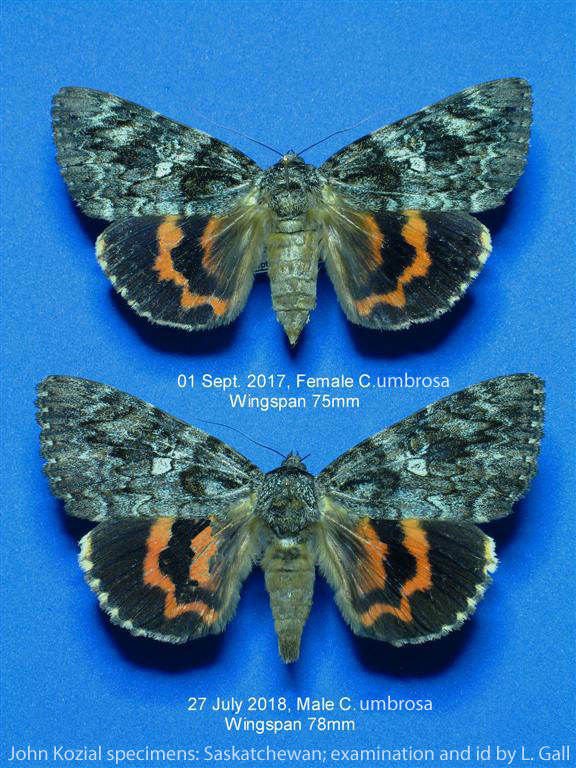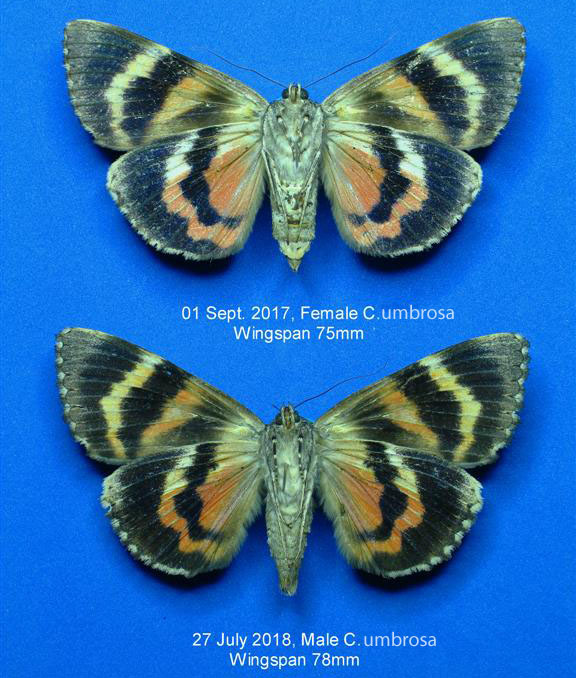Catocala umbrosa
|
|
Updated as per "Systematics of moths in the genus Catocala (Lepidoptera, Erebidae) IV.
Nomenclatorial stabilization of the Nearctic fauna, with a revised synonymic check list";
ZooKeys 39: 37 83 (2010) by Lawrence F. Gall, David C. Hawks; March 21, 2010
Updated as per personal communication with Bill Dempwolf (Austin, Texas; May 19-June 1; 70-77mm); July 3, 2010
Updated as per personal communication with Greg Roehm (Wauchula, Hardee County, Florida; June 18, 2012); August 29, 2012
Updated as per personal communication with Sissy Ffolliot (Essex County, Massachusetts, September 9, 2013; September 15, 2013
Updated as per personal communication with John Kozial (Saskatchewan); January 30, 2019
Updated as per personal communication with Vernon A. Brou, September 12, 2024
Updated as er BOLD, September 12, 2024
|
Catocala umbrosa
kah-TOCK-uh-lahMum-BROH-suh
Brou, 2002

Catocala umbrosa Brou, 2002, Holotype male, courtesy of V. A. Brou.
This site has been created by Bill Oehlke.
Comments, suggestions and/or additional information are welcomed by Bill.
| TAXONOMY:
Superfamily: Noctuoidea
Family: Erebidae, Leach, [1815]
Subfamily: Erebinae, Leach, [1815]
Tribe: Catocalini, Boisduval, [1828]
Genus: Catocala, Schrank, 1802
|
Vernon A. Brou has recently advised me of the following: "By happenstance I today clicked upon the Catocala umbrosa Brou page on your website and noted currently on that page the only
C. umbrosa images are the ones I sent to you decades back, the Type and Allotype.
"The images from
Caddo Parish, Louisiana is C. ilia;
All Texas images are C. ilia;
Mass. image is C. ilia;
Florida image is C. ilia"
DISTRIBUTION:
Catocala umbrosa (wingspan: 70-78mm) flies from Missouri and
Louisiana east to Florida and north through New Jersey to
Massachusetts and Quebec. It has also been confirmed in Saskatchewan
by John Kozial and Larry Gall.

Catocala umbrosa (Ilia; VAB) pair, Saskatchewan, courtesy of John Kozial,
identification confirmed by Larry Gall, January 2019.

Catocala umbrosa (Ilia; VAB) pair, Saskatchewan, courtesy of John Kozial,
identification confirmed by Larry Gall, January 2019.
Vernon A. Brou idicates the specimens depicted above from Saskatchewan, Canada are actually ilia and they are inaccurately recorded for Saskatchewan.
It has also been confirmed in
Arkansas,
Connecticut,
Georgia,
Illinois,
Indiana,
Kansas,
Minnesota,
Mississippi,
New Hampshire,
New York,
North Carolina,
Ohio,
Oklahoma,
Pennsylvania,
Rhode Island,
South Carolina,
Texas and
Virginia.
I suspect it is also in West Virginia.
BOLD, as of September 12, 2024, only confirms Texas, Lousiana, Florida and North Carolina in the US, and Saskatchewan and Manitoba in Canada. The US/Canada reports are very disjoint so I suspect the Canadian references may be of something else. I suspect it is probably limited to the southeastern US. Almost every website indicates different distributions for umbrosa which is very easily confused with ilia. Vernon A. Brou indicates the specimens depicted above from Saskatchewan are not umbrosa and they are not umbrosa. September 14, 2024. I, Bill Oehlke, suspect the "report" from Manitoba is also incorrect.

Catocala umbrosa, (corrected to Catocala ilia; VAB) Essex County, Massachusetts,
September 9, 2013, courtesy of Sissy Ffolliott,
slight digital repair by Bill Oehlke
Tim Dyson has indicated that Moth Photographer's Group has confirmed Catocala umbrosa from Quebec and
Manitoba, Canada. It is very easy to confuse ilia with umbrosa. Possibly the identifications of the Canadian specimens as umbrosa
are in error. However, Larry Gall (2019) has confirmed that specimens from Saskatchewan, collected and submitted by John Kozial, are C. umbrosa.
FLIGHT TIMES AND PREFERRED FOOD PLANTS:
Catocala umbrosa flies as a single generation with moths on the wing from
early April in the southern portions (peak flight in June) of its range through to August in the North (peak flight mid to late July).
Sissy Ffolliott reports a September 9, 2013, flight in Essex County, Massachusetts. Specimen was a bit tattered at that date.
The Catocala umbrosa caterpillar probably feeds on oak species.
Bill Dempwolf sent me this very nice series of Catocala umbrosa from Austin, Texas,
taken May 19 - June 1, 2010, with wingspans ranging from 70-77mm.

Catocala umbrosa, (corrected to Catocala ilia; VAB), Austin Texas, May 2010,
courtesy of Bill Dempwolf, id by Bill Oehlke.

Catocala umbrosa, (corrected to Catocala ilia; VAB), Austin Texas, May 2010,
courtesy of Bill Dempwolf, id by Bill Oehlke.

Catocala umbrosa, (corrected to Catocala ilia; VAB), Austin Texas, May 2010,
courtesy of Bill Dempwolf, id by Bill Oehlke.

Catocala umbrosa, (corrected to Catocala ilia; VAB), Austin Texas, May 2010,
courtesy of Bill Dempwolf, id by Bill Oehlke.
ECLOSION:
Adults eclose from pupae formed under leaf litter.
SCENTING AND MATING:
Catocala umbrosa females emit an airbourne pheromone and males use their antennae to track the scent plume.

Catocala umbrosa Brou, 2002, Allotype female

Catocala umbrosa, (corrected to Catocala ilia; VAB),, Shreveport, Caddo Parish, Louisiana,
courtesy of Rosemary Seidler.
To both myself and Jonathan Willey the moth from Shreveport directly above looks more like piatrix, but Vernon Brou is the expert.
EGGS, CATERPILLARS, COCOONS, AND PUPAE: Eggs are deposited on tree bark in the fall and hatch the following spring.
Larval Food Plants
Listed below are primary food plant(s) and alternate food plants. It is hoped that this alphabetical listing followed by the common
name of the foodplant will prove useful. The list is not exhaustive, although some species seem very host specific.
Experimenting with closely related foodplants is worthwhile.
Return to Main Index

Catocala umbrosa, (corrected to Catocala ilia; VAB),, Wauchula, Hardee County, Florida,
June 18, 2012, courtesy of Greg Roehm.
Use your browser "Back button to return to the previous page.
Goto
This page is brought to you by Bill Oehlke and the
WLSS.
Please send sightings/images to Bill. I will do my best to respond to requests for identification help.
|










